Sheringham to Holt, Norfolk
Some photographs from the North Norfolk Railway steam
heritage line (also known as The Poppy Line) – and environs.
Dating back to 1887, the North Norfolk Railway suffered the usual
vicissitudes of steam, and later diesel, rail services in rural areas.
The commercial line from Norwich to Sheringham survived the Beeching
cuts. Sheringham Station was closed to the public in 1967 when British
Rail built a platform on the east side of Station Road so that trains
no longer had to use the level crossing to reach the station. The
station buldings and platforms were then leased to the Midland and
Great Northern Society, to become part of the North Norfolk Railway. It
was 1975 before the company could offer public passenger trains,
eventually running through to the station at Holt.
Sheringham appears as a place-name in Domesday 1086. The dominance of
the fishing industry eventually gave way to the town becoaming a
seaside holiday resrt. The motto of the town, granted in 1953 to the
Sheringham Urban District Council, is Mare
Ditat Pinusque Decorat, Latin for 'The sea enriches and the pine
adorns'.
Corner Holway Road/Cromer Road (south
of the station)
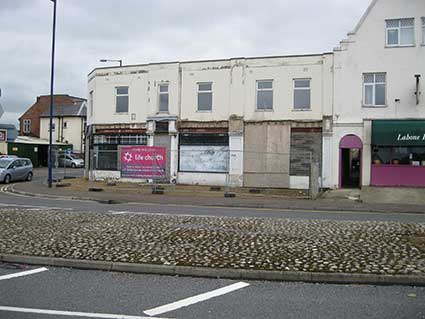
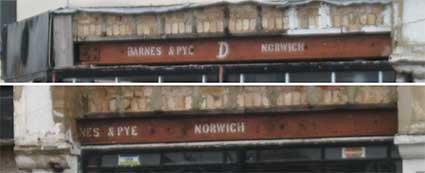 2022 images
2022 images
Sometimes, removal of a shop name-board will reveal
previously hidden lettering on the structure beneath. Here the steel
girders bear the words:
'BARNES & PYE NORWICH'
which is repeated round the corner on Holway Road. John
Barnes is listed in the 1865 Kelly’s
Post Office Directory as ‘iron and brass founder, Church Street,
St Miles’ in Norwich, but the foundry was to be known variously as (a)
Barnes Ironworks, (b) Barnes and Pye as a partnership (between Jacob
Pye and John Youngs - dissolved on the latter's death in 1929) and as a
company (Barnes and Pye Ltd from 1962 until dissolved in 2006) and also
as (c) the St Miles Foundry.
Station Hotel/Dolphin, Railway
Approach
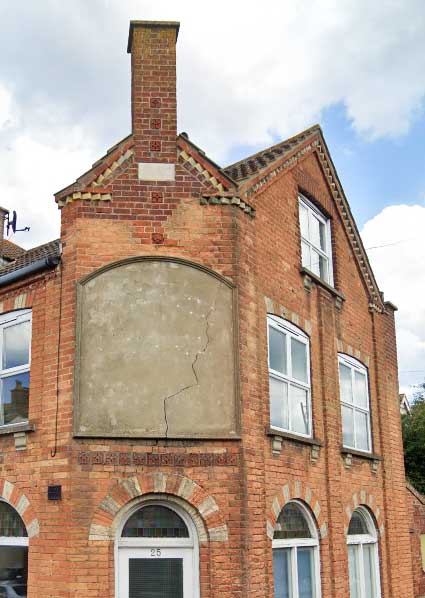
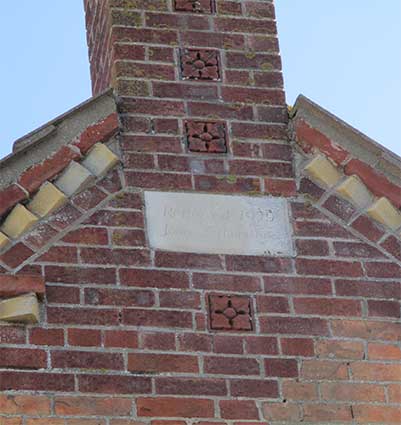
The tablet reads: 'Renewed 1979; John Fetherstone'. The Dolphin was
situated on Railway Approach. This pub closed in 1975. 'The building of
the former Station Hotel still stands opposite the Railway Station, on
the Corner of Station Approach and St Peter’s Road. Licensed in 1896
but with no public bar until 1904, in the 1960s it became the Dolphin
Hotel,around the time parts of the station and some of the lines were
closing. The Dolphin pub sign from c.1963 shows a painting of a Dolphin
and the name of then owners Bullards brewery – as well as its obvious
maritime connections, ‘Dolphin’ might also refer to the nautical term
for a structure consisting of a number of piles driven into the seabed
as a mooring point. It has since been converted into residential and
office accommodation, now St Peter’s House.' [Information from Pints & pubs,
Sheringham website]
The Robin Hood, 13-15 Station Road
(corner with New Road). We must also credit the 'Pints & pubs'
website for this image of a fine, quirky piece of terra cotta
decoration in a gable triangle on The Robin Hood.
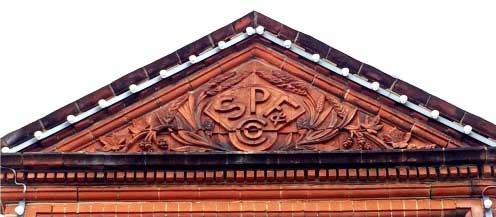 Image from Pints & pubs, Sheringham website
Image from Pints & pubs, Sheringham website
'SPF&
Co'
Steward, Patteson, Finch & Co. was a Norfolk
brewery founded in 1793 and using this name from 1837 to 1895; the
company became Steward & Patteson after that. (For an example of
the latter monogram, see our Uncle Tom's
Cabin, Ipswich page.) It declined and
closed as a brewery in the mid-1970s. The diminutive ampersand tucks in
below the overhang of the 'F'. The 'Co.' is easy to mss from the street
with the three-quarters of a circle 'C' enclosing the circular 'O'. The
Robin Hood building dates to mid-19th century, the pub was renamed in
1904.
St Peters Road
 15 St Peters Road
15 St Peters Road
Just down the road from the former Dolphin, it's worth
mentioning this terrace of three-storey, flint-faced houses on St
Peters Road. The decorative features all point to 'seaside resort'
architecture.
Church Street/High Street
Further into the town centre, a group of buildings on the west side
feature framed monograms within three-dimensional cartouches. W.H.
Smith is the last in Chrch Street, the next three addresses are in High
Street.
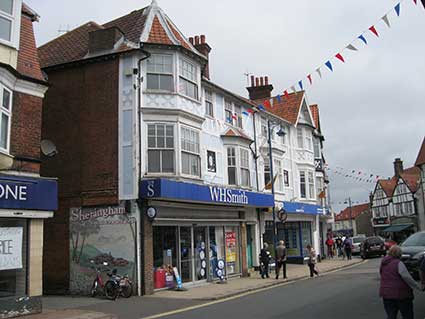
Below: '1894' in extravagent, condensed numerals; 'H' and '1897'; 'SJP'
(or other permutations); 'WHB' (or other
permutations).

1 High Street
Sea View Hotel overlooked the Promenade. 'This shabby, empty Victorian
building overlooking the promenade, between the Two Lifeboats and the
Crown, was once the Sea View Hotel, more recently Shannocks, finally
closing under the name No.1 Bistro Bar. As Shannocks Hotel in the early
2000s, it advertised “a spacious bar open to everybody all year round”,
serving “a full range of beers, lagers, wines, spirits and soft
drinks”, with “all tables having a panoramic view of the sea”.' [Information from Pints
& pubs, Sheringham
website]
These photographs date from 2020 showing various
fugitive lettering; the building has since been demolished and the land
turned into a car park.
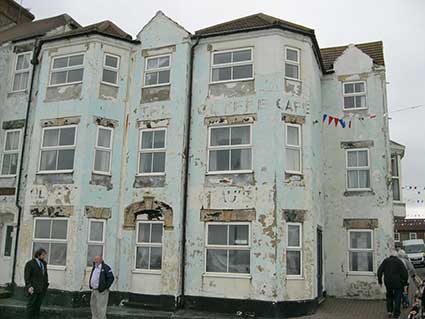 2020 images
2020 images
Below: close-ups show that 'THE CLYFFE CAFE /
RESTAURANT' was another name used.


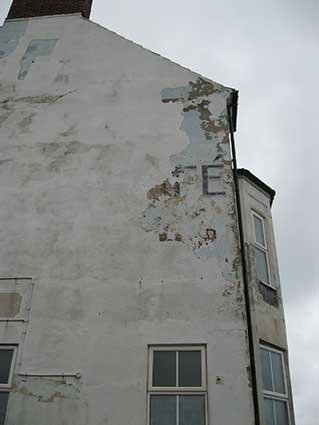
Vestigial lettering: 'ICES' (twice), 'SERVED HERE'
(perhaps from that very window, '[CA]FE' (up high). Below:
'ENTRA[NCE]', 'SE...' (?), 'ICED TEAS SNAC[KS]', 'ICES'.
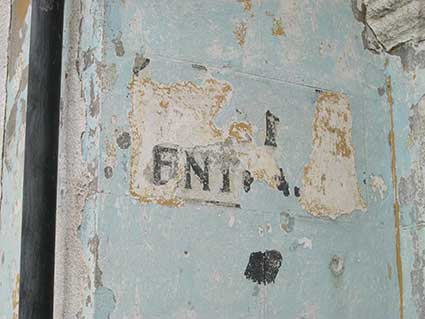
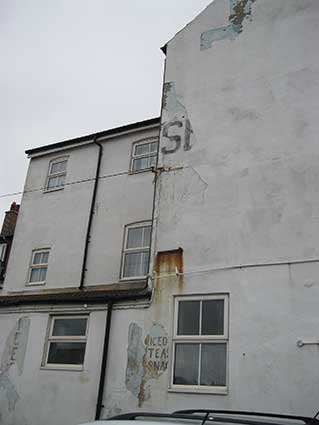
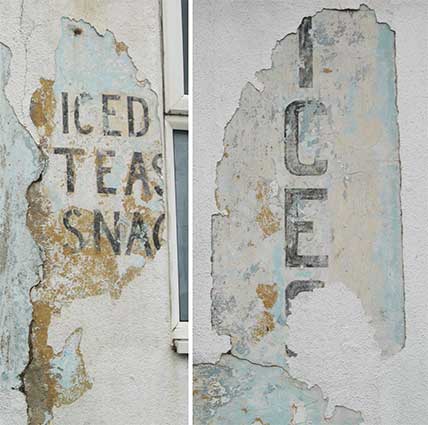
The steam railway
Sheringham is now nationally famous as a heritage steam
line – a tribute to good management and invaluable volunteering. Here
are some photographs from May 2022 on their Steam Gala Day.
Historic lettering examples are scattered throughout, albeit many of
them recreated by skilled signwriters during the renovation process.
 A
A
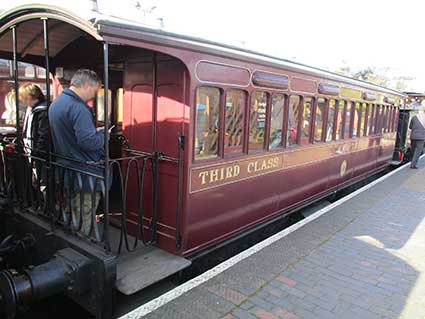 B
B
 C
C
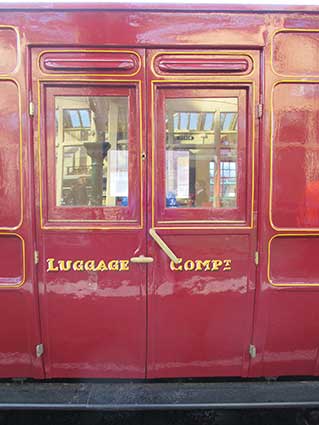 D
D
 E
E
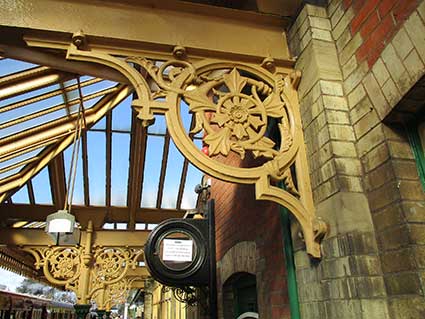 F
F
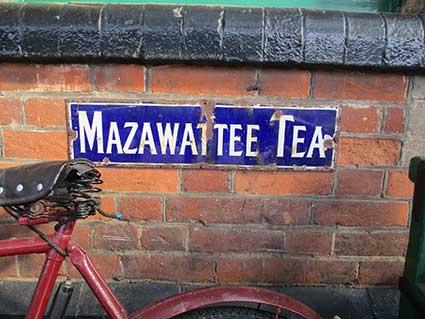 G
G
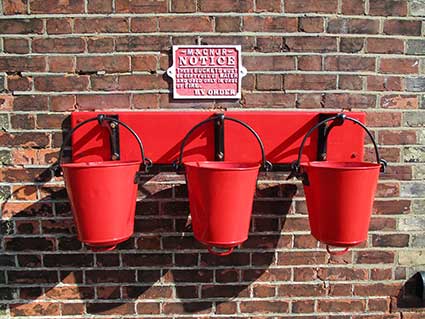 H
H
 I
I
 J
J
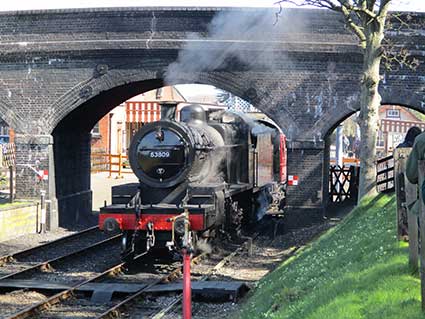 K
K
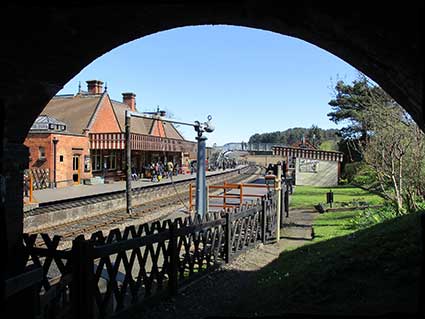 L
L
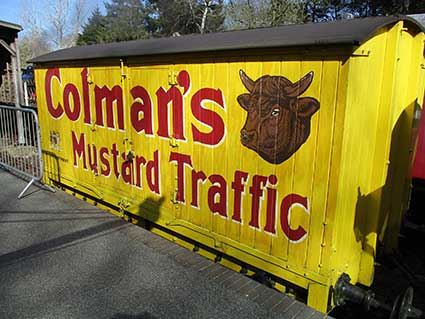 M
M
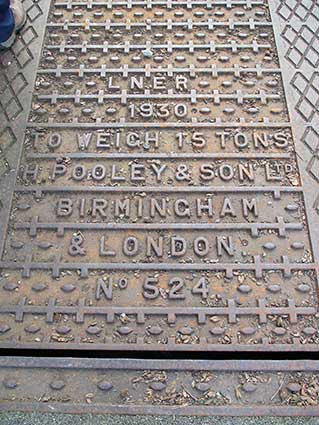 N
N
Notes: A. G.E.R. armorial – probably a vinyl decal – of
the railway company (see also an example in the Church of St Mary-at-Stoke, Ipswich).
F. cast iron spandrel supporting the platform canopy featuring, within
a circle, a foliate five-pointed star with a smaller version in the
centre with tendrils adding an Art Nouveau touch.
G. The Mazawattee Tea Company, founded in 1887, used Hindi words
meaning 'pleasure of the garden' after 1953 the firm was sold to a
subsidiary of Burton, Son & Sanders Ltd
of Ipswich;
H. Fire-buckets (note the lower handles to aid throwing of water at the
seat of a fire) – 'M&GNJR NOTICE - THESE BUCKETS MUST BE KEPT FULL
OF WATER AND USED ONLY IN CASE OF FIRE. BY ORDER'
L. Weybourne Station has a brick-built road bridge and a metal
footbridge over the line.
N. cast weighbridge cover by 'H. POOLEY & SON LTD'; this was a
mechanical engineering company specialising in the manufacture of
weighing machines and based in Liverpool then later in Birmingham. An
example of the company's weighing machines can be found on Platform 2
of Ipswich railway station (bottom of
page).
Holt milepost
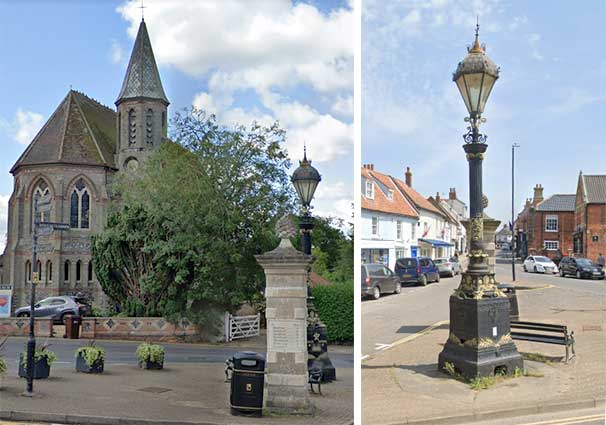
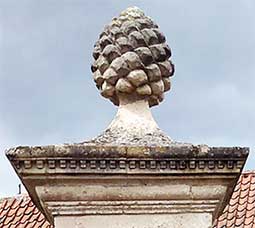
The two views above show both the stone milepost topped
with a stone
pineapple (symbolising good fortune), with an ornate cast iron street
lamp on 'Obelisk Plain'. Both structures have been moved from
elsewhere. 'The High Street terminates where it reaches the A148 King’s
Lynn to Cromer road but dominating this busy ‘T’ junction is the United
Methodist Chapel, designed by Thomas Jekyll of Norwich, and considered
to be one of the finest examples of Victorian church architecture in
the UK. Built in 1863 for the then huge sum of £2,000 the turreted
spire was originally designed to accommodate a clock, but the high
building costs meant the circular brickwork panels remain empty.'
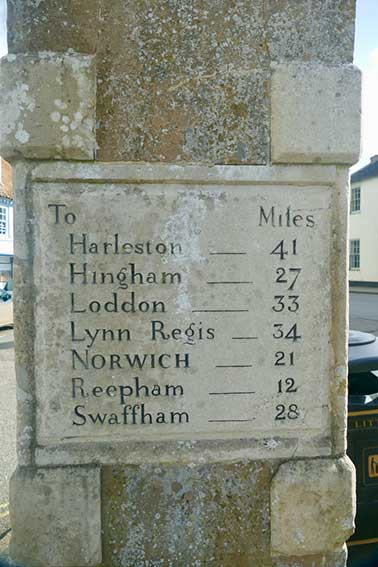 2023 image courtesy David
Gaylard
2023 image courtesy David
Gaylard
The brief Historic England Grade II Listing text is
revealing: 'Mid C18. Limestone. Rectangular on plan. Rusticated quoins.
Carved
pineapple finial on classical cornice. Said to have been moved from the
Melton Constable estate.'
'The pineapple topped obelisk is one of a pair of gateposts relocated
from Melton Constable Park, the other was given to the town of East
Dereham in 1757. Each stone panel bears the distance in miles to
various locations in Norfolk, calculated correctly when the
gatepost originally stood at the entrance to Melton Constable Hall and
the reason why the mileages are not at all accurate from Holt. At the
start of World War II, the townsfolk of East Dereham decided to dump
their obelisk down a well so as not to assist the enemy in the event of
an invasion. The four panels on Holt's obelisk were simply white-washed
over!
The Queen Victoria Golden Jubilee Lantern was erected in 1887 and
originally stood in the centre of the Market Place. In 1921 the Lantern
was moved to Obelisk Plain in order to make way for Holt’s War
Memorial. The light was powered by the town’s rather unreliable gas
supply proving so erratic that the light was more ‘off-than-on’,
earning it the nickname of ‘Blind Sam’. The copper lantern housing
mysteriously disappeared which prompted a restoration scheme in the
1990s where an exact replica was built using the original design
drawings.' [Information from Holt Owl Trail website]
Home
Return
to Historic Lettering from outside
Ipswich
Please email any comments
and contributions by clicking here.
Search Ipswich
Historic Lettering
©2004
Copyright
throughout the Ipswich
Historic Lettering site: Borin Van Loon
No reproduction of text or images without express written permission

 2022 images
2022 images

 Image from Pints & pubs, Sheringham website
Image from Pints & pubs, Sheringham website 15 St Peters Road
15 St Peters Road

 2020 images
2020 images





 A
A
 B
B
 C
C
 D
D
 E
E
 F
F G
G
 H
H I
I
 J
J K
K
 L
L M
M
 N
N

 2023 image courtesy David
Gaylard
2023 image courtesy David
Gaylard